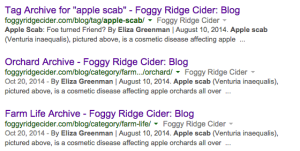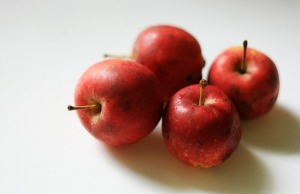Last fall, I wrote a blog entry for my previous employer talking about apple scab, and how brix tests have shown that apples with scab have a higher sugar content than apples without scab. The article got a lot of attention and sparked some new (and much needed) conversations, and I should have saved what I had written (so I could post it here). You see, I wanted to reblog it today, but have realized that it has been taken down since I left. This is all very interesting to me and has basically supplied me with content for today’s blog entry: Being a radical orchardist.

Part 1: Fungal Disease People want affordable organic, and that’s usually not possible unless you grow it yourself or start eating ugly (cosmetically blemished) fruit. Fungal diseases like apple scab can largely be controlled by orchard cleanliness: breaking down the leaves after they fall, making sure the fruits are all picked up, pruning for good air flow (and removing the debris) and selecting apple genetics that aren’t as prone. Despite these efforts, however, you’re likely to still get some disease in your orchard. To the commercial dessert fruit grower, this is a bad thing because a scabby apple is an unsaleable apple. But to the cider maker, I think we’ve thought this more of a problem than it actually is. My article I wrote for my previous employer (seen in the snapshot above-right) said that after repeated trials with my refractometer and a bunch of apples, I found that apple scab raises the brix, or sugar content, of an apple due to the apple’s response to the fungal stress. Higher brix= higher sugar content=more alcohol in cider. I have spent a little time researching the nutritional content of apples with scab compared to apples without scab, and the overall nutrition of the apple is higher with scab (click to read that blog post). To me, that’s a value added disease if managed for moderation…especially if the apple hasn’t been repeatedly slathered with fungicides (organic or inorganic). Yet, we North Americans have been taught to only accept the most beautiful of apples, ones free of cosmetic blemishes, and that is why fungicides are sprayed at alarming rates in orchards across the continent.
(Hewes Virginia Crab, without fungicide or insecticide)
Dessert fruit is NOT process/cider fruit, so why are cideries accepting apples that have, in my opinion, been inferiorly managed for cider? The short answer is this: Unless cideries are growing their own apples, they have to buy from conventional growers. The information given from extension agents is how to grow dessert fruit, not cider fruit, and there is a difference. There’s such a shortage of cider apples that cider makers really don’t have much choice at the moment to question growing practices, and they aren’t at a point to talk with the growers about management.
This also begs the question: What is a cider apple? Sure, you can have all the old French and English varieties like Dabinett, Frequin Rouge, Tremletts Bitter, Norfolk Beefing, etc, but if they are managed the same as dessert apples…are they really cider apples? I don’t think so.
But back to where I said that these apples are being inferiorly managed for cider… Here’s a scary example: If you work within the cider or wine realm, you’ll learn that fermentations have been known to delay due to the late season sprays of sulfur based fungicides like Captan (a broad spectrum fungicide) on apples and grapes arriving at the press. Some cider makers I have talked with said that their ferments have stopped before and they attribute it to late season fungicide sprays. This means that some of the yeast added to the juice to start the transition from juice to alcohol died due to the fungicide residue on the apples. A fungicide used to keep the dessert fruit beautiful. Those who spray Captan will sing the praises of how, if used in combination with IPM practices, it will hardly leave an environmental impact. Yet, if the residue is killing the yeast during fermentation, I can’t imagine what it is actually doing to the environment and the person spraying it in its concentrated form. Also, imagine what it is doing to the flora in your gut. This isn’t talked about. Cider is new with consumers, so they don’t yet know the questions to ask. I once asked a couple dessert apple growers who have traditional cider apple varieties why they are treating their cider apples the same as their dessert fruit. “It’s cheaper to manage them all the same,” they said. I think the truth actually rests within the realm of “Doing something different to the cider apples is a pain in the ass.” Which is, basically, the mantra of almost every apple grower (minus about 30 people) I’ve ever met. Would you rather drink cider from an ugly apple free of chemicals which encourages a healthy fermentation, or a cider from conventional dessert fruit apples that has to be babied with all sorts of enzymes, yeast nutrient and other additives due to an ill fermentation? Would you rather eat an affordable, organic apple with cosmetic blemishes, or one that has been repeatedly sprayed with chemicals in order to ensure it’s beauty? That’s a radical thought, and it’s what I’m after.
I’m excited to learn and work towards building a different cider story. It’s such a new industry… there’s room for a rewrite. Understanding the insects, preserving diversity in the soil, working with more disease resistant genetics, managing for the site… it’s all so radical, yet so very practical.
Questions to ask your local cider company:
1.) What percentage of apples do you import from other orchards in order to make your cider? (I can list 3 cideries off the top of my head who grow ALL of their own apples. It’s not many)
2.) Are the apples you are buying grown as dessert fruit? Or grown as cider fruit? (Ask them to differentiate)
3.) What are the management practices of these growers? Do they spray a late-season fungicide to prevent the cosmetic diseases apple scab and powdery mildew? Consumer awareness can change the ethics of agriculture. By asking these questions, correcting your buying habits and telling your friends what you have learned, growers and cider makers will eventually have to give in to change. That’s how Ag works in America, unfortunately.

Good questions, and glad you are asking them.
Not at all radical, although it is so interesting to hear that these ideas are considered radical. Our ancestors were apparently radical.
At the Northern MI Small Farms Conference this year, I was sitting next to a conventional fruit grower in Michael Phillips presentation on his pest/disease management protocols (where he lists off maybe 6-10 quite expensive organic treatments—neem, BT, you know the drill…). The grower leans over at the end and says, “Shit man, I’d have to raise my prices 4 times to pay for those sprays. No one’s gonna pay that. Plus we don’t spray that much, maybe $400 for 4 acres worth of spraying.” So even what organic orchardists are proposing is quite radical!
You familiar with the Aaron Burr Cider folks? Nice article here on their ethics as such: http://www.ediblemanhattan.com/departments/traceability/tree-knowledge/#.UstGKdWF_XI.facebook
Allison and I have some ideas about being potential radical Southern apple growers…
Mark! So excited about that little Virginia apple radical clue! I will help you guys out in all ways humanly possible.
A true cider apple is defined by variety, not by the growing method. How a grower manages a Kingston Black tree does not take away it’s excellent qualities as a cider producing apple.
With all respect, I tend to disagree. Growing apples is every bit as artisanal as making cider; it involves a skilled hand and the right processes. Transforming a dessert apple to a cider apple is, at first, in the management. Excellent products start with excellent ingredients, and are you sure the Kingston Black is at it’s best in your cider if grown as a dessert fruit?
Fascinating and thought provoking. Fungus pressure isn’t so much an issue in my dry northern CA orchard, which hasn’t been sprayed in at least 30 years and has almost no scab, although codling moth is a bit of a problem. As a hobbyist grower and cider maker I don’t worry much about cosmetics anyway. Still, it can’t be impossible to go no spray in more humid environments. Steve Gougeon at Bear Swamp Orchard (bearswamporchard.com) seems to be making it work.
Pingback: Nibbles: Year of the Goat, Nutritional guidelines, Healthy diets, IK & conservation, Healthy orchards, Indian endemics trouble, CWR garden, NGS & food security, 3000 rice genomes at work, C4 rice, It’s economics stupid, US animal products ma
Pingback: Nibbles: Year of the Goat, Nutritional guidelines, Healthy diets, IK & conservation, Healthy orchards, Indian endemics trouble, CWR garden, NGS & food security, 3000 rice genomes at work, C4 rice, It’s economics stupid, US animal products ma
We are in the Pacific NW and I share a lot of the same opinions as you do regarding orchard practices and quality of ferment able sugars. We manage a certified organic orchard and vineyard. Would like to compare notes on what best practices should and can be. Please send me and email when you have time.
I manage a orchard and vineyard and totally agree with you. Would love to compare notes on best practices in low input orchards.
Yes, agreed! Send me an email at egreenman (at) gmail (dot) come.
Pingback: Stress: The New Bittersweet? (A Radical Orchardist Part 2) | unconventional stories from a young apple farmer